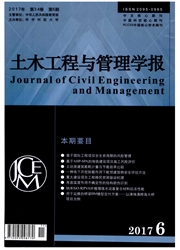

 中文摘要:
中文摘要:
结构的倒塌边缘比率(CMR ) 的决心被许多不明确的因素影响。能影响 CMR 的计算的一些因素,例如,在倒塌,地震紧张措施的决心,地震危险概率,和差别以前的结构的基本时期的延伸光谱在扎根的运动和设计的中部的光谱之间的形状光谱,被讨论。就结构的基本时期的延伸而言,紧张措施 S < 潜水艇 class= “ a-plus-plus ” >(T 1 ) 应该被 S 代替 < 潜水艇 class= “ a-plus-plus ” > 在为短时期、中等时期的结构的 CMR 的计算的 * 。合理紧张措施应该被在地震紧张措施和结构的损坏索引之间的关联分析决定。否则, CMR 应该根据地震危险概率和差别被调整在光谱形状。为重要长时期的结构, CMR 应该被特殊地点光谱决定。结果两个都显示那 S < 潜水艇 class= “ a-plus-plus ” >(T 1 ) 和光谱紧张(SI ) 能为中等时期的结构在 CMR 的计算被用作紧张措施,但是 SI 将是为长时期的结构的一种更好的选择。而且,反映结构的实际地震倒塌安全的调整 CMR 被提供。
 英文摘要:
英文摘要:
The determination of collapse margin ratio (CMR) of structure is influenced by many uncertain factors. Some factors that can affect the calculation ofCMR, e.g., the elongation of the structural fundamental period prior to collapse, the determination of earthquake intensity measure, the seismic hazard probability, and the difference of the spectral shapes between the median spectrum of the ground motions and the design spectrum, were discussed. Considering the elongation of the structural fundamental period, the intensity measureSa(T1) should be replaced with*aS in the calculation of CMR for short-period and medium-period structures. The reasonable intensity measure should be determined by the correlation analysis between the earthquake intensity measure and the damage index of the structure. Otherwise, CMR should be adjusted according to the seismic hazard probability and the difference in the spectral shapes. For important long-period structures, CMR should be determined by the special site spectrum. The results indicate that bothSa(T1) and spectrum intensity (SI) could be used as intensity measures in the calculation of CMR for medium-period structures, but SI would be a better choice for long-period structures. Moreover, an adjusted CMR that reflects the actual seismic collapse safety of structures is provided.
 同期刊论文项目
同期刊论文项目
 同项目期刊论文
同项目期刊论文
 期刊信息
期刊信息
